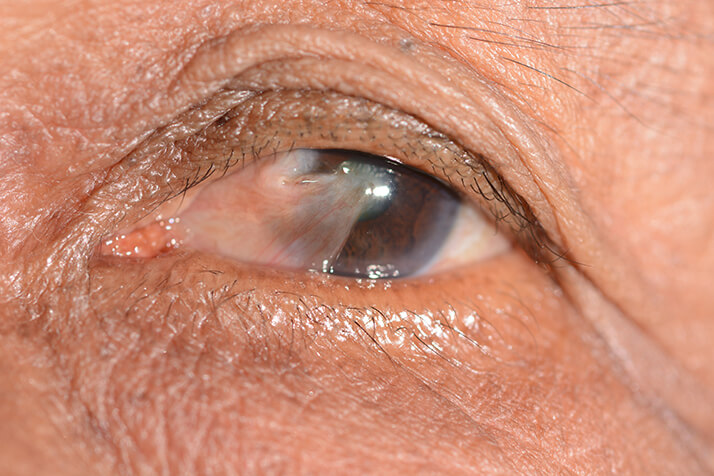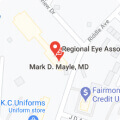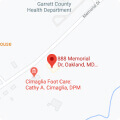
What is Pterygium?
A pterygium (pronounced “tur-RIDGE-ium”) is fleshy tissue that grows over the cornea (the clear front window of the eye). It may remain small or may grow large enough to interfere with vision. A pterygium most commonly occurs on the inner corner of the eye but can appear on the outer corner as well. The pterygium can vary in appearance- a small hard to see tissue mass to a large red and very noticeable growth. Because pterygium varies in appearance it may be yellow, gray, white, pink, red, or even colorless. It may even have blood vessels.
Causes of Pterygium
UV radiation (usually from sunlight) is the most common cause of pterygium. This explains why pterygium occurs with increasing frequency in climates approaching the equator. Other causes include continuous exposure to dry, dusty environments. People who spend significant time in water sports (surfing or fishing) are particularly susceptible to pterygium because of the intense exposure to UV that occurs in these environments. When the eye is continuously assaulted by UV rays, the conjunctiva may thicken in a process similar to callus formation on the skin. The sensitive structures of the outer eye often can not comfortably tolerate this degenerative process, and irritation, redness, foreign body sensation, and ocular fatigue can result.
Preventing Pterygium
The best method of preventing pterygium is to regularly wear UV 400 rated sunglasses when outdoors in sunny conditions. Sunglasses with a wrap-around design provide better protection than those with large gaps between the sunglass frame and the skin around the eyes. Wearing a hat with a wide brim provides valuable additional protection.
Pterygium Symptoms
It is possible that a patient with pterygium has no symptoms, but this rare. Symptoms are usually first noticed on the conjunctiva, and then is noted to gradually grow onto the cornea of the eye.
History of Pterygium Removal Surgery
In pterygium surgery, the abnormal tissue is removed from the cornea and sclera (white of the eye). Over the years, pterygium surgery has evolved significantly, and modern pterygium surgery has a significantly higher success rate than conventional surgery.
In traditional “bare sclera” pterygium removal, the underlying white of the eye (sclera) is left exposed. Healing occurs over two to four weeks with mild to moderate discomfort. Unfortunately, the pterygium may grow back in up to 50% of patients. In many cases, the pterygium grows back larger than its original size.
Over the years, surgeons have used several different techniques to lessen the likelihood of pterygium recurrence, including radiation treatment and the use of “antimetabolite” chemicals that prevent growth of tissue. Each of these techniques has risks that potentially threaten the health of the eye after surgery, including persistent epithelial defects (ulceration in the surface of the eye), and corneal melting.
Conjunctival Autograft with Stitches
Most cornea specialists today perform pterygium surgery with a conjunctival autograft because of a reduced risk of recurrence. In this technique, the pterygium is removed, and the cornea regains clarity. However, the gap in the mucous membrane (conjunctiva) tissue, where the pterygium was removed, is filled with a transplant of tissue that has been painlessly removed from underneath the upper eyelid. Although the procedure requires more surgical skill than traditional surgery, this “auto-graft” (self-transplant) helps prevent re-growth of the pterygium by filling the space where abnormal tissue would have re-grown. Autografts performed in conjunction with antimetabolite agents can reduce the recurrence risk to about 5%.
In conventional autograft surgery, stitches are used to secure the graft in place on the eye. These can cause discomfort for several weeks.
The desire for a quicker, more painless recovery has led to the development of no-stitch pterygium/autograft surgery. This is accomplished through the use of tissue glue or adhesive. In very active patients and in larger grafts we have found the autografts are more secure with suturing techniques.
Expectations After Surgery
After surgery, the eye will be patched overnight. Topical antibiotic and anti-inflammatory drops and or ointments will be used to minimize the pain and help with the healing. Your surgeon will monitor your healing. Patients will experience some discomfort in the first days after surgery. Most people can resume activity within 48 hours after the surgery process.
Despite proper surgical removal, the pterygium may return, particularly in young people. Protecting the eyes from excessive ultraviolet light with proper sunglasses and avoiding dry, dusty conditions and use of artificial tears may also help.
*As with any surgical procedure there are risks along with benefits. It is important to discuss your surgical procedure with your surgeon to fully understand the risks and benefits.






